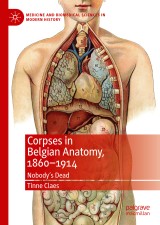Details

Corpses in Belgian Anatomy, 1860-1914
Nobody's DeadMedicine and Biomedical Sciences in Modern History
|
CHF 67.50 |
|
| Verlag: | Palgrave Macmillan |
| Format: | |
| Veröffentl.: | 20.11.2019 |
| ISBN/EAN: | 9783030201159 |
| Sprache: | englisch |
Dieses eBook enthält ein Wasserzeichen.
Beschreibungen
This book tells the story of the thousands of corpses that ended up in the hands of anatomists in the late nineteenth and early twentieth centuries. Composed as a travel story from the point of view of the cadaver, this study offers a full-blown cultural history of death and dissection, with insights that easily go beyond the history of anatomy and the specific case of Belgium. From acquisition to disposal, the trajectories of the corpse changed under the influence of social policies, ideological tensions, religious sensitivities, cultures of death and broader changes in the field of medical ethics. Anatomists increasingly had to reconcile their ways with the diverse meanings that the dead body held. To a certain extent, as this book argues, they started to treat the corpse as subject rather than object. Interweaving broad historical evolutions with detailed case studies, this book offers unique insights into a field dominated by Anglo-American perspectives, evaluating the similaritiesand differences within other European contexts. <p></p>
1 Introduction.- 2 Anatomy is Done?.- 3 From Deathbed to Dissecting Table: Acquiring Anatomical Material.- 4 Under the Scalpel: Dividing the Body.- 5 The Jar and the Coffin: Keeping and Disposing of the Dead.- 6 Conclusion.
<p><b>Tinne Claes</b> is a Postdoctoral Researcher at the Cultural History since 1750 Research Group at the University of Leuven, Belgium, and Fellow of the Research Foundation – Flanders (FWO), Belgium. </p>
This book tells the story of the thousands of corpses that ended up in the hands of anatomists in the late nineteenth and early twentieth centuries. Composed as a travel story from the point of view of the cadaver, this study offers a full-blown cultural history of death and dissection, with insights that easily go beyond the history of anatomy and the specific case of Belgium. From acquisition to disposal, the trajectories of the corpse changed under the influence of social policies, ideological tensions, religious sensitivities, cultures of death and broader changes in the field of medical ethics. Anatomists increasingly had to reconcile their ways with the diverse meanings that the dead body held. To a certain extent, as this book argues, they started to treat the corpse as subject rather than object. Interweaving broad historical evolutions with detailed case studies, this book offers unique insights into a field dominated by Anglo-American perspectives, evaluating the similaritiesand differences within other European contexts.
Examines the impact of changing medical practices and cultural attitudes towards death and the donation of bodies to medical facilities at the turn of the twentieth century Takes a unique methodological approach, following the trajectory of the corpse in anatomy from acquisition to disposal Offers new insights into understudied European centres, drawing comparisons with other continental cases and showing how religious and cultural ideas influenced the practice of dissection
“In this fine book Tinne Claes takes the history of anatomy out of the nineteenth century and into our own times. She shows that, to understand the hitherto little studied transition from body snatching and the shame of dissection to voluntary donation in the service of science, we must follow both anatomists and prospective cadavers as they move through the physically and socio-politically transforming city: from hospital beds and dissection halls to political arenas and burial grounds.” (Tatjana Buklijas, University of Auckland, New Zealand )<div><br></div><div>“The coercive laws and secret arrangements through which nineteenth-century anatomists obtained the corpses of the poor are better known than how anatomical donation became the norm in the twentieth century. This ground-breaking book argues that democratic politics and egalitarian attitudes – from the rise of consent in clinics to less punitive approaches to poverty – forced change on anatomy around 1900. By reconstructing anatomists’ post-mortem practices and the stories of those they dissected, Tinne Claes offers a compelling account of how nobodies began to become somebodies.” (Nick Hopwood, author of Haeckel’s Embryos: Images, Evolution, and Fraud (2015))</div>
Diese Produkte könnten Sie auch interessieren:

The Last Samurai - Japanische Geschichtsdarstellung im populären Kinofilm

von: Daniel Scherrer

CHF 54.99

Harz-Zeitschrift für den Harz-Verein für Geschichte und Altertumskunde

von: Harzverein für Geschichte und Altertumskunde e.V.

CHF 17.00














